Electronic Circuits
 | BJT DC Load Switching Transistor
This is the first circuit to support the BJT Transistor Theory TEDIE Book. In this page we analyze the transistor operating as a DC Load Switch.
|
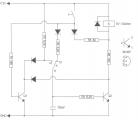 | Bistable relay
javascript:PopUpWindow('/userpages/images/Bistable_relay_1.jpg',600,400)
|
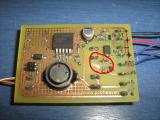 | SMPS with Battery Backup and NiMH Charger using the LM2595
I designed an SMPS buck regulator with 2xAA NiMh battery trickle charger and power failure output. I designed this circuit mainly to gain experience with SMPS regulators, and to pair it with a boost regulator that i made some time ago and make a nice power supply with power failure light!
|
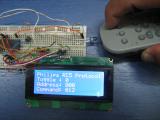 | Philips RC5 single LED Decoder and Transmitter circuit
I made this circuit for two reasons: first i wanted to make an assembly library to decode and transmit RC5 IR data, and second because i wanted to test an idea that i had to make an IR transceiver (reader and transmitter) using only one IR LED.
|
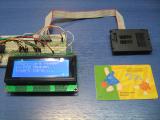 | PIC Smartcard Phonecard Reader
I made this circuit for 3 purposes: First, to demonstrate how can someone read the data of a Smart-card and more specifically a telecard (phonecard), second to provide the tools in the means of an assembly inc file to everyone that wishes to read smartcards with PIC and assembly, and third to prepare prepare myself for my next project...
|
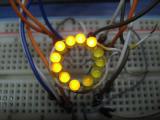 | HDD LED Spindicator
I found a nice idea from a site for my PC mod. Viktor made a replica of a spindicator - a HDD IDE indicator with 10 LEDs in a circle which revolve as pulses arrive from the HDD LED of the motherboard. I thought like spicing it up by adding 12 LEDs controlled with 12 individual PWM drivers.
|
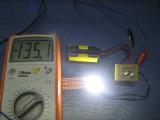 | High Efficiency Battery Boost Regulator using the MCP1640
I love camping, and i plan to make some gadgets for my summer holidays in nature. Electric power is something that you cannot find in abundance when you camp at the sea side, but sun and batteries are... So, i got this MCP1640 chip from Microchip to make an evaluation board and see what this tiny thing can do, by powering 2 high power LEDs with 2 heavily used batteries.
|
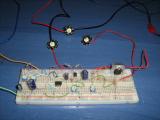 | Flexible 555 LED Pulsing (Breathing) Circuit
The previous breathing LED circuit became very popular, but it had a major drawback: It was designed to operate with 5 volts only. After receiving many requests for a 12V breathing LED circuit, i decided to design a more flexible one. This circuit operates with 12 to 15 volts and has an adjustable voltage oscillation in terms of amplitude and DC offset.
|
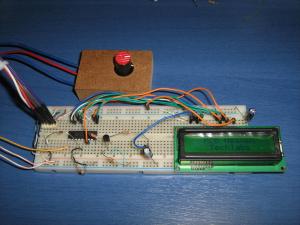 | PWM LCD Contrast Adjustment
The HD44780 is a very popular Character LCD Controller very widely used. The backlit of such LCDs is usually implemented with LEDs, so a simple PWM driver can directly adjust the brightness. Unfortunately, the PWM module cannot be directly used to adjust the contrast. So, i made a very simple and small circuit to interface the PWM output of a microcontroller to the contrast adjustment pin of the HD44780 Character LCD.
|
 | A 555 Breathing (Pulsing) LED
I plan to finish the PC case mod that i began some years ago, and i need a breathing (pulsing) LED circuit. I designed a very simple and very adaptive breathing LED circuit to use it for the power switch. The circuit uses a 555 timer chip and two transistor amplifiers, and has different adjustments for the fade-in and fade-out times.
|
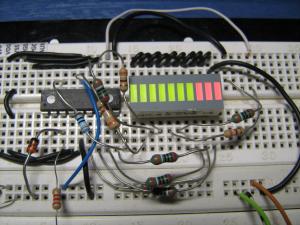 | PC Fan RPM Bargraph Meter and Failure Alarm with PIC
This is a very special page, because this is the first circuit designed and implemented by a PCB Heaven visitor. He made a PC Fan RPM meter with bargraph using the PIC16f628 microcontroller. The sampling rate is excellent, and the bargraph has 10 LEDs to indicate the approximate speed.
|
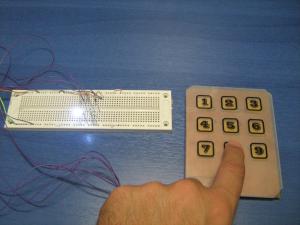 | 10 Buttons PIC Touch-Pad with BCD Output
This circuit is a very reliable and accurate touch keypad with 10 keys. I use a PIC with a built in capacitance 16-channel module. The keypad is interfaced via a 4-bit binary code. I plan to use this keypad for my keycode door-lock circuit.
|
 | LCD PIC Clock with the Maxim DS1307 RTC
A friend of mine asked me to design a home automation for him. He wants me to build something that will communicate with his air condition through an IR receiver that it has, and it will act as a programmable timer, to turn it on and off automatically. This circuit will help you understand how to use the built-in I2C communication module of PIC microcontrollers, and also how to use the Maxim DS1307 Real Time Clock chip.
|
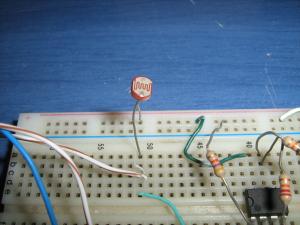 | Automated Light Controller with adjustable Sensitivity and Hysteresis
This circuit controls some high brightness LEDs according to the amount of light that falls on a photocell (LDR). The circuit is based on the Schmitt Trigger and has an adjustable sensitivity and hysteresis. I will use it to control the backlit on a touch panel, but it can be used for security night light control.
|
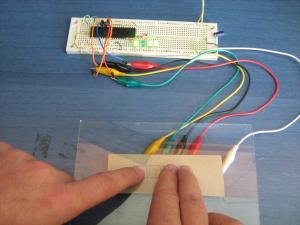 | PIC Capacitance Sensor with 4 buttons and Multitouch Function
This circuit utilizes the built-in capacitance sensor of a PIC microcontroller, to implement a 4 button touch pad. This PIC can be extended up to 16 buttons, but i wanted to keep it simple. You can easily extend it though. Moreover, the touch pad functions as a multi-touch pad!
|
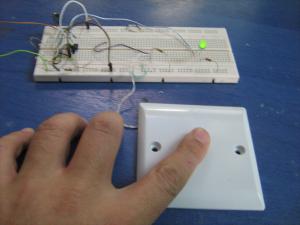 | PIC Frequency-Change Capacitance Touch Button
This is the first capacitance touch sensor that i present in my site. This is a PIC-based touch sensor that uses the Frequency-Change technique to sense a touch. The code is written in a way that, even if someone has no experience at all with PIC programming but can provide himself a PIC programmer, he can make the touch button work easily.
|
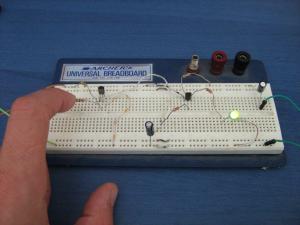 | DIY AC Hum Touch Button
The AC Hum touch sensor is a special touch sensing technique, rarely used for switching applications. Because it has only one electrode, it is often confused with the capacitance touch sensor, but that is not true. In this page i make a simple pushbutton and an ON-OFF switch to demonstrate this method.
|
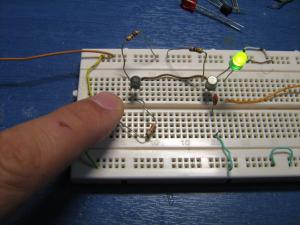 | DIY Resistance Touch Button
This is the first type of touch sensors that i will present, after publishing the theory of touch sensors. I made a resistance touch button with some variations. First, a typical resistance momentary touch button, and then i changed this circuit to drive a relay. Finally, i added a dual Flip-Flop IC and made a resistance toggle touch button.
|
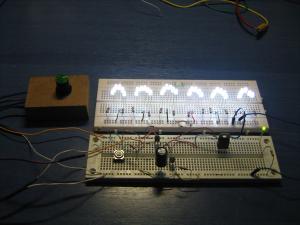 | LED Fade-In Fade-Out Dimmer
The fade-in and fade-out effect gives a cool look and feel to electronic projects. I made two simple analog fade-in fade-out circuits to control multiple LEDs. It can also be used for you car dome light or for off-delay security light.
|
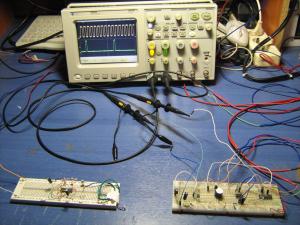 | Long Range (10mt) IR Beam Break Detector
After i published the precision short distance (2cm) IR beam cut detector, i began receiving mails and comments from people asking me how to increase the range. That was impossible with the previous circuit. So, i designed a new reliable long range IR beam cut detector. During tests, i managed to get 10 meters of range (33 feet) with no false triggers.
|
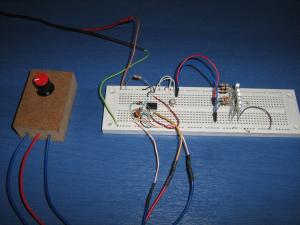 | An LED Array PWM Dimmer with the 555
Connecting the 555 as a PWM generator, i drive with it an LED array. This circuit performs an LED PWM dimmer with minimum components and high power efficiency, especially in low LED brightness. It can be powered in a wide voltage range from 4 up to 15 volts. Along with its compact size, it is ideal for camping or night fishing, and generally whenever mobility and long-time use is required.
|
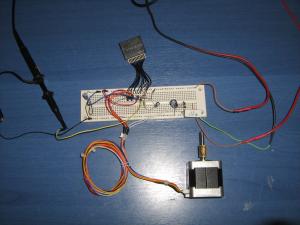 | Full and Half Stepper Motor Controller with the Sanyo STK672-110
A full and Half wave stepper motor controller for 2-phase hybrid unipolar stepper motors. The circuit uses the STK672-110 hybrid chip from Sanyo and 7 external simple components. The speed is controlled with the frequency of a pulse signal, while the rotation direction is controlled with a single wire.
|
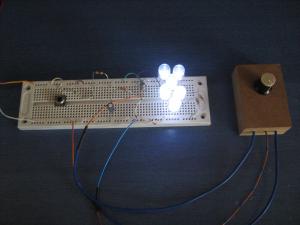 | LED Off Delay with dimming effect
This is an extremely simple LED off delay circuit with dimming effect. A pushbutton turns on a number of LEDs, which are kept on as long as the button is pressed. When the button is released, an off-delay will keep the LEDs turned on for an amount of time. Then, the LEDs will start dimming slowly, until they are completely turned off. I have include 4 different schematic diagrams for 4 different power supplies (5, 9, 12 and 15 volts). A single circuit can control up to 104 LEDs @ 15Volts.
|
 | Fixed Countdown Timer For -Geek- Gamers
I made this simple fixed-time countdown timer for my favorite game, Men Of War. It starts the countdown with the press of a button. During the countdown, the LED flashes. The closer the countdown is to 0 seconds, the faster the LED flashes. Also, the circuit has a buzzer for acoustic notifications. It can be used for many other purposes that a countdown is required.
|
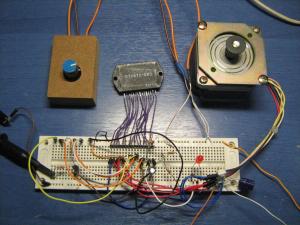 | A Microstepping Driver with the Sanyo STK672-080
I found this incredible STK672 series chip from Sanyo and i made a micro-stepping unipolar hybrid 2-phase stepper motor controller. The circuit is ridiculously simple, while the operation of the 200 steps per cycle motor is extremely smooth with minimum vibrations.
|
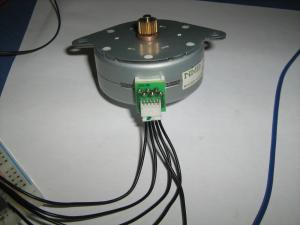 | Simple Unipolar Stepper Motor Full Step Controller
This is a very simple circuit for controlling unipolar stepper motors with full step rotation. The circuit uses no microcontroller and no special ICs, except a common 4017 CMOS. The speed of the rotation can be controlled by the frequency of the input pulses.
|
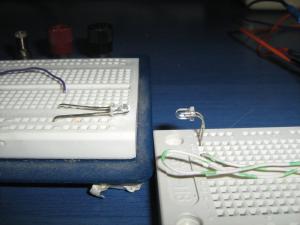 | IR Short Distance Beam Cut Detector
A very sensitive IR beam-cut detector pair, for small distances (up to 2.5cm - 1 inch). Can be used for rotary encoders, limit switches or other applications that require precision but no long distance beams. It can be fine adjusted to the point that it will not only detect a beam cut, but it will also detect semi-transparent objects such as plastic bags and other semi-transparent films.
|
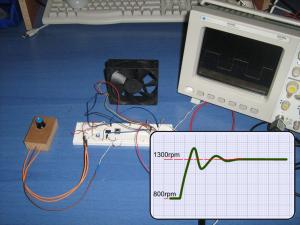 | Closed Loop high frequency PWM PC Fan Controller
This circuit performs a closed loop PWM fan controller. This means that the potentiometer, does NOT directly sets a duty cycle value. Instead, it sets an RPM reference value. The controller will increase or decrease the duty cycle automatically, until the real fan speed matches to the reference rpm value from the potentiometer. This way, the fan will not decrease the speed due to dust or bearing wear.
|
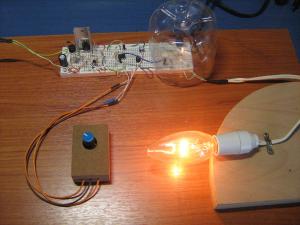 | PIC DCV Controlled AC Light Dimmer
Another AC dimmer controlled by a DC voltage level. These dimmers are very flexible, as they can be controlled with a potentiometer, or a PLC, or a photocell, or anything else that provides a DC control voltage, without changing the circuit!
|
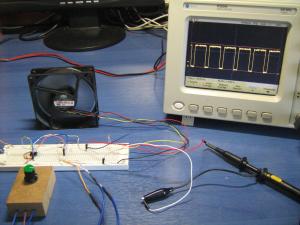 | High Frequency PWM Fan Controller
This is the classic PWM fan controller with the 555 timer chip. The frequency of the pulses is around 21 KHz, beyond the acoustic band. The circuit is designed to be used with 4-wire fans, nevertheless i have add a variation of the circuit for 3-wire fans that works just as well. The rpm on a 4-wire fan can go as low as the internal controller permits, and for the 3-wire fan i achieved speeds around 200rpm - useless but fascinating.
|
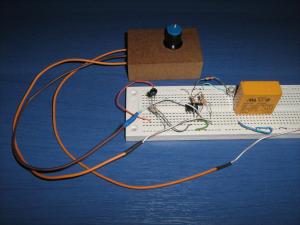 | A Simple yet Reliable Thermostat
This circuit is a thermostat made of a few components and a 741 chip. This circuit can be adjusted from 22 to 50 degrees Celsius with a hysteresis of about 2 degrees. It is originally designed for cooling applications like the PC box or an electric cabinet. I give detailed info though, how to change the range and the hysteresis to use it as you may.
|
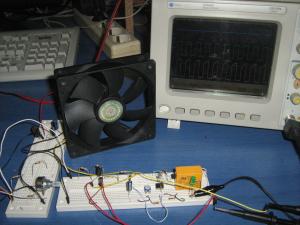 | PC Fan Failure Alarm
This circuit will use the tacho output of PC fans (3-wire and 4-wire fans only) to check their condition. The circuit can be adjusted according to the lowest speed of the fan. In case that the fan rotates slower than the preset value or if the fan stalls, a buzzer (or a relay) is actuated. The circuit will reset itself if the fan rotates itself. I have another variation that the circuit will only reset if the acknowledge button is pressed.
|
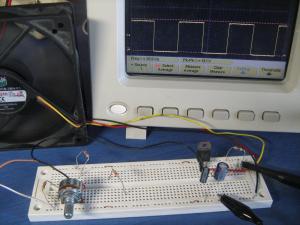 | Simple Linear Fan Controller
This is the simplest linear fan controller circuit. It can control the speed of a fan using a potentiometer, a transistor, 2 resistors and 2 capacitors.
|
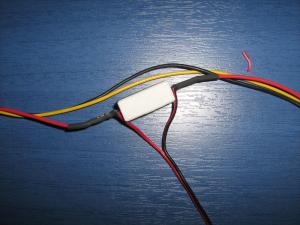 | Simple Ways to Make Fans Silent
This is the simplest way of reducing the speed of a DC fan. The circuit needs only a properly selected resistor to operate. Adding a switch, the circuit is turned into a 2-speed fan controller
|
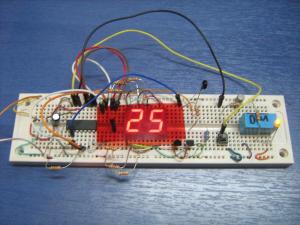 | PIC Thermometer and Thermostat
This circuit is a thermometer/thermostat especially designed for etching baths. It will display the etching solution temperature, and moreover, it will control the heating element, so that the solution will be always 1 degree Celsius around 40 degrees. It uses a NTC sensor to measure the temperature, and a relay to control the heater.
|
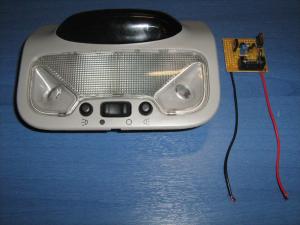 | Car Dome Light Off-Delay
One day, a friend of mine came to me holding in his hand the dome light from his car. "Its does not work properly" he said. "When i close the door, the light turns off immediately". This circuit is a replacement for the car dome light off-delay circuitry. Depending on the light bulb that is used, this circuit will turn off the lamp by dimming it slowly.
|
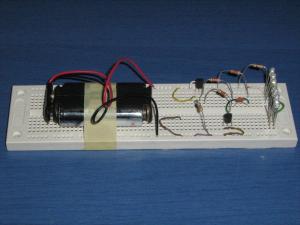 | Miniature 2.4 Volts LED Flasher
A LED flasher suitable for bicycles. It is powered from 2 x 1.5 or even 2 x 1.2 volts (rechargeable) batteries! It sends 2.5Hz pulses to high brightness LEDs, according to the international laws for bicycle safety flashing lights. The LEDs are very bright and can be seen from a very ling distance. What's incredible is the long life of the batteries. The circuit that i am testing has 7 3mm ultra bright (15.000 mcd each) LEDs, and is powered with 2 x 1.2 volts 2500mA rechargeable batteries. I turned it on on the 11th of January 2010 at around 20:00 o'clock. When the batteries run out of energy, i will post the results of the battery life.
|
 | Voltage Controlled AC Light Dimmer
This circuit was a request from a friend. He wanted me to design a dimmer circuit, that it could be controlled from the 0-10 Volts DC analog output from a PLC module. The circuit had to be precise and steady. Also, he asked me, if possible, not to use microcontroller.
|
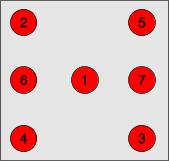 | Electronic Dice
This is a simple but interesting circuit. Not really practical application, but the way that the LEDs are driven to perform the dice numbers is really interesting.
|
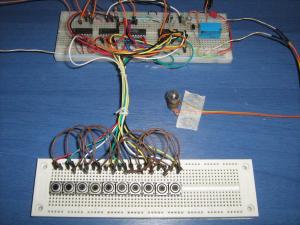 | Simple Keycode Lock
This is a very simple and yet secure key-code circuit without the use of micro-controller. The code is hardware programmable up to 4 bits but with slight changes it can grow bigger.
|
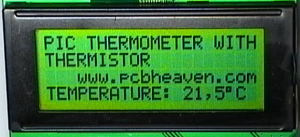 | Low Cost PIC Thermometer
This low-cost circuit will use the built in ADC (analog to digital converter) module of the PIC microcontroller to measure the output voltage of a voltage divider consisted of a metal film resistor and a NTC thermistor. The PIC will then use the characteristic line (slope and offset) of the thermistor to calculate the temperature.
|
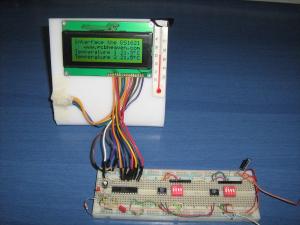 | PIC Precision Thermometer using the DS1621
A high accuracy temperature meter using a PIC 16F631 and the DS1621 cascadeable temperature meter chip from Dallas semiconductors. The implementation is done with two DS1621. It can be extended up to 8 chips with using only 2 communication lines from the PIC and with very slight modification to the code. The results are shown on a 20x4 LCD display.
|
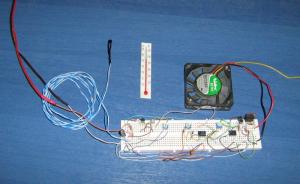 | Two Speed Temperature Fan PWM Controller
This circuit can be used for PC box ventilation, CD Rom cooler or any other application that requires a fan to operate periodically. It turns on and off according to the temperature applied to a temperature sensor. The fan speed can be set to low and full speed according the temperature level.
|
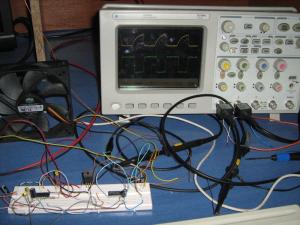 | PIC 3-Wire Fan RPM Controller
The circuit performs a fan PWM controller with rpm feedback and automatic tunning. It has the ability to self-regulate the PWM duty cycle according to the real fan rpm, and re-adjust them to meed exactly the desired value. There are 5 pre-defined fine speeds that can be selected with a single switch.
|
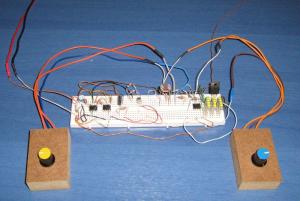 | Ambient Light Level Equalizer
This is a circuit to keep your luminosity in a steady level. A light source (LEDs, light bulb etc) will light bright or dim, according to the ambient light. Very useful for adjusting luminosity of 7-segs and LCD backlits.
|
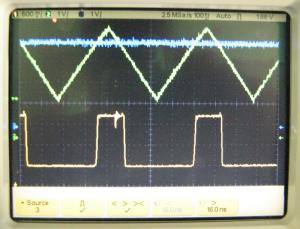 | Voltage Controlled PWM Generator
This is a PWM signal generator that will control the duty cycle of the output pulses, from a DC voltage level input from any source. The circuit uses a comparator and a triangle waveform to operate.
|
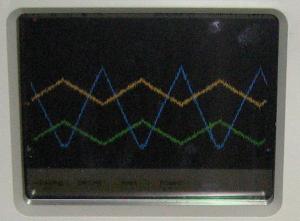 | Triangle Wave Generator
A very simple and yet useful circuit for generating triangle wave. It uses two OP-AMPS and the oscillation frequency is chosen from a resistor and a capacitor
|
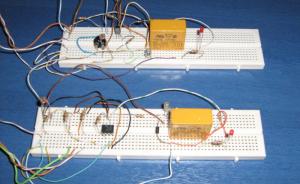 | Light / Dark Activated Relay
Three very popular and effective light/dark switching circuits are put under the microscope. PCBHeaven tech labs will test, present and compare those circuits for you to choose the best to fit your needs!
|
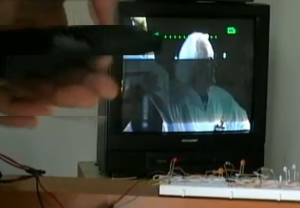 | TV Remote Control Jammer
This is a very simple circuit to have fun with your friends and not only. This circuit will generate a series of infrared light pulses that will block the remote control signals to the TV, the stereo, the DVD and generally any remote control that uses IR light.
|
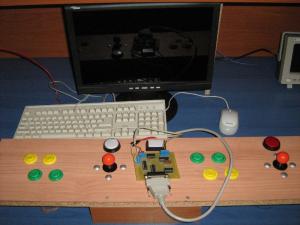 | MAME Arcade-style console circuit
This circuit will let you interface 24 (or more) inputs as well as a PS2 keyboard to a single PC PS2 port. The 24 inputs will correspond to 24 keyboard keys. This circuit completely eliminates the problem that exists when playing MAME and the player (one or more players) clicks many buttons simultaneously...
|
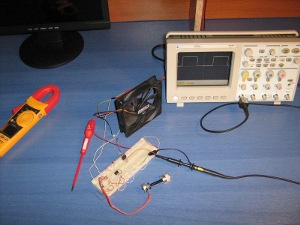 | Linear DC motor speed controller using a simple PWM switching mode power supply
This is a very simple but really efficient circuit to control the fan speed of the computer case (or whatever). The circuit is composed by a 555 timer and some 9-10 other simple components, so that it can be made from even an amateur. It also carries the ability for the 3-wired fans to sent rpm feedback to an rpm counter.
|
|

 Home
Home
 Projects
Projects
 Experiments
Experiments
 Circuits
Circuits
 Theory
Theory
 BLOG
BLOG
 PIC Tutorials
PIC Tutorials
 Time for Science
Time for Science
 Contact
Contact
 Forum
Forum
 Projects
Projects
 Experiments
Experiments
 Circuits
Circuits
 Theory
Theory
 BLOG
BLOG
 PIC Tutorials
PIC Tutorials
 Time for Science
Time for Science
 RSS
RSS